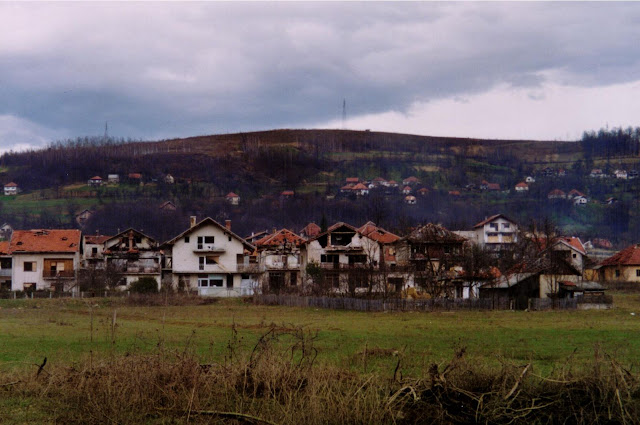Blog 02: The Bosnian "Safe Havens" during the war
Blog 2: The Bosnian “Safe Havens”
Very early in the beginning of the war, ethnic cleansing was used as weapon mainly by the Bosnian Serbs, however also the Croats and in some cases the Muslims executed ethnic cleansing. The following map is an overview of the amount of death during what has been seen as formal ethnic cleansing.
In light of the total amount of 100,000 victims as result of the war it seems very ironically that only the numbers on the map have been seen as massacres. During the siege of Sarajevo nearly 14,000 civilians were killed, many of them as result of the same hate and deadly attacks as during the massacres and this map shows that formal definitions of massacres, ethnic cleansing and genocide are often questionable and hardly to understand by the victims.
In the beginning of the Bosnian war in East Bosnia, Bosnian Muslim survivors fled into three eastern enclaves where the Bosnian republican army had resisted: Gorazde, Zepa and Srebrenica and their populations swelled by displaced deportees, cowering, bombarded relentlessly and largely cut off from supplies of food and medicine. The population of Srebrenica swelled from 9,000 to 42,000, and by March 1993 the situation was sufficiently horrific that Philippe Morillon on 12 March 1993 lead a convoy into the battered pocket and promised: “You are now under the protection of the UN forces. I will never abandon you.”
In light of the total amount of 100,000 victims as result of the war it seems very ironically that only the numbers on the map have been seen as massacres. During the siege of Sarajevo nearly 14,000 civilians were killed, many of them as result of the same hate and deadly attacks as during the massacres and this map shows that formal definitions of massacres, ethnic cleansing and genocide are often questionable and hardly to understand by the victims.
In the beginning of the Bosnian war in East Bosnia, Bosnian Muslim survivors fled into three eastern enclaves where the Bosnian republican army had resisted: Gorazde, Zepa and Srebrenica and their populations swelled by displaced deportees, cowering, bombarded relentlessly and largely cut off from supplies of food and medicine. The population of Srebrenica swelled from 9,000 to 42,000, and by March 1993 the situation was sufficiently horrific that Philippe Morillon on 12 March 1993 lead a convoy into the battered pocket and promised: “You are now under the protection of the UN forces. I will never abandon you.”
UN commander in chief General Morillon promised Srebenica sufficient protection.
In 1993 under several resolutions by the United Nations Security Council, a number of humanitarian area’s were established in Bosnia. On 16 April 1993 with the United Nations Council Resolution 819 & 836 Srebrenica was declared as “Safe haven”. On 6 May under Security Council Resolution 824 also Sarajevo, Zepa, Gorazde, Tuzla and Bihac were also declared as “Safe Haven” and were placed under the protection of the UN peacekeeping units of UNPROFOR.
However the Security Council resolutions 819, 824 and 836, which governed the "protection of the Safe Havens", were full of weasel words. The peacekeepers were to 'deter' attacks on the town (the UN avoided the more explicit terms 'defend' or 'protect'), and the use of force was authorised but linked to 'self-defence'.
The resolution created a difficult diplomatic situation because the member states that voted in favor of it were, for political reasons, not willing to take the necessary steps to fully ensure the security of the safe areas. Following the resolutions 819 and 836 the protection of these “Safe Havens” should be done by “all necessary means, including the use of force”
Despite the "Safe Haven Status" both Zepa and Srebrenica were overrun by the Bosnian Serbs, which lead to the massacre of Srebrenica and multiple killings in Zepa.
During our trip we visited Srebrenica, Tuzla and Sarajevo. Following advise of the Dutch consul of the Dutch embassy in Sarajevo, we did not visit Zepa due to the bad road after the strong winter with heavy snowfall. Also Gorazde and Bihac aren't visited, Bihac is located in West-Bosnia and we had lack of time to visit Gorazde.
However the Security Council resolutions 819, 824 and 836, which governed the "protection of the Safe Havens", were full of weasel words. The peacekeepers were to 'deter' attacks on the town (the UN avoided the more explicit terms 'defend' or 'protect'), and the use of force was authorised but linked to 'self-defence'.
The resolution created a difficult diplomatic situation because the member states that voted in favor of it were, for political reasons, not willing to take the necessary steps to fully ensure the security of the safe areas. Following the resolutions 819 and 836 the protection of these “Safe Havens” should be done by “all necessary means, including the use of force”
Despite the "Safe Haven Status" both Zepa and Srebrenica were overrun by the Bosnian Serbs, which lead to the massacre of Srebrenica and multiple killings in Zepa.
During our trip we visited Srebrenica, Tuzla and Sarajevo. Following advise of the Dutch consul of the Dutch embassy in Sarajevo, we did not visit Zepa due to the bad road after the strong winter with heavy snowfall. Also Gorazde and Bihac aren't visited, Bihac is located in West-Bosnia and we had lack of time to visit Gorazde.





Comments
Post a Comment